Solar eclipse of June 17, 1909
A total solar eclipse occurred at the Moon's ascending node of orbit on Thursday, June 17, 1909,[1][2][3] with a magnitude of 1.0065. It was a hybrid event, with only a fraction of its path as total, and longer sections at the start and end as an annular eclipse. A solar eclipse occurs when the Moon passes between Earth and the Sun, thereby totally or partly obscuring the image of the Sun for a viewer on Earth. A total solar eclipse occurs when the Moon's apparent diameter is larger than the Sun's, blocking all direct sunlight, turning day into darkness. Totality occurs in a narrow path across Earth's surface, with the partial solar eclipse visible over a surrounding region thousands of kilometres wide.
The path of totality crossed central Russia, the Arctic Ocean, northeastern Ellesmere Island in Canada, Greenland, and annularity crossed southern Siberia in Russia (now in northeastern Kazakhstan and southern Russia) and southern Greenland.
Related eclipses
Eclipses in 1909
- A total lunar eclipse on June 4, 1909.
- A hybrid solar eclipse on June 17, 1909.
- A total lunar eclipse on November 27, 1909.
- A partial solar eclipse on December 12, 1909.
Metonic
- Preceded by: Solar eclipse of August 30, 1905
- Followed by: Solar eclipse of April 6, 1913
Tzolkinex
- Preceded by: Solar eclipse of May 7, 1902
- Followed by: Solar eclipse of July 30, 1916
Half-Saros
- Preceded by: Lunar eclipse of June 13, 1900
- Followed by: Lunar eclipse of June 24, 1918
Tritos
- Preceded by: Solar eclipse of July 18, 1898
- Followed by: Solar eclipse of May 18, 1920
Solar Saros 145
- Preceded by: Solar eclipse of June 6, 1891
- Followed by: Solar eclipse of June 29, 1927
Inex
- Preceded by: Solar eclipse of July 7, 1880
- Followed by: Solar eclipse of May 29, 1938
Triad
- Preceded by: Solar eclipse of August 16, 1822
- Followed by: Solar eclipse of April 17, 1996
Solar eclipses of 1906–1909
This eclipse is a member of a semester series. An eclipse in a semester series of solar eclipses repeats approximately every 177 days and 4 hours (a semester) at alternating nodes of the Moon's orbit.[4]
| Solar eclipse series sets from 1906 to 1909 | ||||
|---|---|---|---|---|
| Ascending node | Descending node | |||
| 115 | July 21, 1906 Partial | 120 | January 14, 1907 Total | |
| 125 | July 10, 1907 Annular | 130 | January 3, 1908 Total | |
| 135 | June 28, 1908 Annular | 140 | December 23, 1908 Hybrid | |
| 145 | June 17, 1909 Hybrid | 150 | December 12, 1909 Partial | |
Saros 145
This solar eclipse is a part of Saros cycle 145, repeating every 18 years, 11 days, 8 hours, containing 77 events. The series started with a partial solar eclipse on January 4, 1639, and reached a first annular eclipse on June 6, 1891. It was a hybrid event on June 17, 1909, and total eclipses from June 29, 1927, through September 9, 2648. The series ends at member 77 as a partial eclipse on April 17, 3009. The longest eclipse will occur on June 25, 2522, with a maximum duration of totality of 7 minutes, 12 seconds. All eclipses in this series occurs at the Moon's ascending node.
| Series members 10–32 occur between 1801 and 2359 | ||
|---|---|---|
| 10 | 11 | 12 |
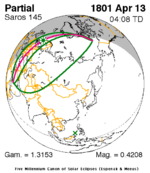 April 13, 1801 | 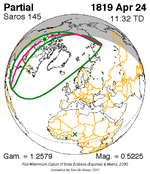 April 24, 1819 | 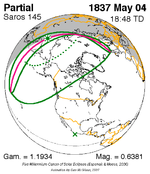 May 4, 1837 |
| 13 | 14 | 15 |
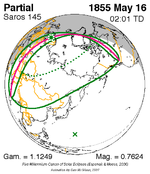 May 16, 1855 | 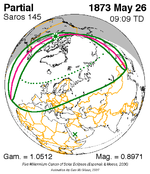 May 26, 1873 | 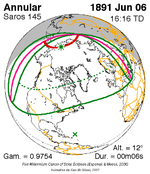 June 6, 1891 |
| 16 | 17 | 18 |
 June 17, 1909 |  June 29, 1927 |  July 9, 1945 |
| 19 | 20 | 21 |
 July 20, 1963 |  July 31, 1981 |  August 11, 1999 |
| 22 | 23 | 24 |
 August 21, 2017 |  September 2, 2035 |  September 12, 2053 |
| 25 | 26 | 27 |
 September 23, 2071 |  October 4, 2089 | 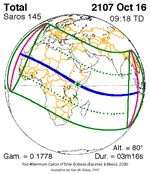 October 16, 2107 |
| 28 | 29 | 30 |
 October 26, 2125 |  November 7, 2143 | 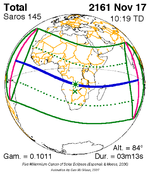 November 17, 2161 |
| 31 | 32 | 33 |
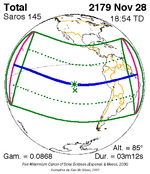 November 28, 2179 |  December 9, 2197 |  December 21, 2215 |
| 34 | 35 | 36 |
 December 31, 2233 |  January 12, 2252 | 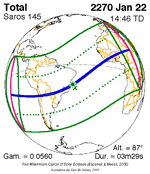 January 22, 2270 |
| 37 | 38 | 39 |
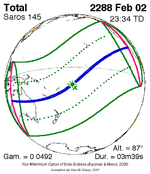 February 2, 2288 | 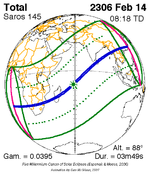 February 14, 2306 | 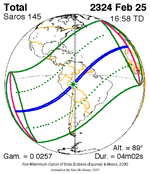 February 25, 2324 |
| 40 | ||
 March 8, 2342 | ||
External links
- ^ "First eclipse of sun for this year today". Knoxville Sentinel. Knoxville, Tennessee. 1909-06-17. p. 4. Retrieved 2023-11-01 – via Newspapers.com.
- ^ Frederic J. Haskin (1909-06-17). "Eclipse of the sun". The Salt Lake Herald. Salt Lake City, Utah. p. 4. Retrieved 2023-11-01 – via Newspapers.com.
- ^ "Today's shadow of the sun scarcely visible in this region". Daily News-Republican. Lawton, Oklahoma. 1909-06-17. p. 1. Retrieved 2023-11-01 – via Newspapers.com.
- ^ van Gent, R.H. "Solar- and Lunar-Eclipse Predictions from Antiquity to the Present". A Catalogue of Eclipse Cycles. Utrecht University. Retrieved 6 October 2018.
- Earth visibility chart and eclipse statistics Eclipse Predictions by Fred Espenak, NASA/GSFC
- Google interactive map
- Besselian elements
- v
- t
- e
| By era | |
|---|---|
| Saros series (list) | |
| Visibility | |
| Historical |
|

Total/hybrid eclipses
→ next total/hybrid
- 1133
- 1185
- 1560
- 1598
- 1652
- 1654
- 1673
- 1706
- 1715
- 1724
- 1766
- 1778
- 1780
- 1806
- 1816
- 1824
- 1842
- 1851
- 1853
- 1857
- 1858
- 1860
- 1865
- 1867
- 1868
- 1869
- 1870
- 1871
- 1874
- 1875
- 1878
- 1882
- 1883
- 1885
- 1886
- 1887
- Jan. 1889
- Dec. 1889
- 1893
- 1896
- 1898
- 1900
- 1901
- 1903
- 1904
- 1905
- 1907
- Jan. 1908
- Dec. 1908
- 1909
- 1910
- 1911
- Apr. 1912
- Oct. 1912
- 1914
- 1916
- 1918
- 1919
- 1921
- 1922
- 1923
- 1925
- 1926
- 1927
- 1928
- 1929
- Apr. 1930
- Oct. 1930
- 1932
- 1934
- 1936
- 1937
- 1938
- 1939
- 1940
- 1941
- 1943
- Jan. 1944
- 1945
- 1947
- 1948
- 1950
- 1952
- 1954
- 1955
- 1956
- 1957
- 1958
- 1959
- 1961
- 1962
- 1963
- 1965
- 1966
- 1967
- 1968
- 1970
- 1972
- 1973
- 1974
- 1976
- 1977
- 1979
- 1980
- 1981
- 1983
- 1984
- 1985
- 1986
- 1987
- 1988
- 1990
- 1991
- 1992
- 1994
- 1995
- 1997
- 1998
- 1999
- 2001
- 2002
- 2003
- 2005
- 2006
- 2008
- 2009
- 2010
- 2012
- 2013
- 2015
- 2016
- 2017
- 2019
- 2020
- 2021
- 2023
- 2024
- → 2026
- 2027
- 2028
- 2030
- 2031
- 2033
- 2034
- 2035
- 2037
- 2038
- 2039
- 2041
- 2042
- 2043
- 2044
- 2045
- 2046
- 2048
- 2049
- 2050
- 2052
- 2053
- 2055
- Jan. 2057
- Dec. 2057
- 2059
- 2060
- 2061
- 2063
- 2064
- 2066
- 2067
- 2068
- 2070
- 2071
- 2072
- 2073
- 2075
- 2076
- 2077
- 2078
- 2079
- 2081
- 2082
- 2084
- 2086
- 2088
- 2089
- 2090
- 2091
- 2093
- 2094
- 2095
- 2096
- 2097
- 2099
- 2100
- 2186

Annular eclipses
→ next annular
- 1820
- 1854
- 1879
- 1889
- 1900
- 1901
- 1903
- 1904
- 1905
- 1907
- 1908
- 1911
- 1914
- Feb. 1915
- Aug. 1915
- 1916
- 1917
- 1918
- 1919
- 1921
- 1922
- 1923
- 1925
- 1926
- 1927
- 1929
- 1932
- Feb. 1933
- Aug. 1933
- 1934
- 1935
- 1936
- 1937
- 1939
- 1940
- 1941
- 1943
- Jul. 1944
- 1945
- 1947
- 1948
- 1950
- Mar. 1951
- Sep. 1951
- 1952
- Jan. 1954
- Dec. 1954
- 1955
- 1957
- 1958
- 1959
- 1961
- 1962
- 1963
- 1965
- 1966
- Mar. 1969
- Sep. 1969
- 1970
- 1972
- Jan. 1973
- Dec. 1973
- 1976
- 1977
- 1979
- 1980
- 1981
- 1983
- 1984
- 1987
- 1988
- 1990
- 1991
- 1992
- 1994
- 1995
- 1998
- 1999
- 2001
- 2002
- 2003
- 2005
- 2006
- 2008
- 2009
- 2010
- 2012
- 2013
- 2014
- 2016
- 2017
- 2019
- 2020
- 2021
- 2023
- → 2024
- 2026
- 2027
- 2028
- 2030
- 2031
- 2032
- 2034
- 2035
- 2036
- Jan. 2038
- Jul. 2038
- 2039
- 2041
- 2042
- 2043
- 2044
- 2045
- 2046
- 2048
- 2049
- 2052
- 2053
- Jan. 2056
- Jul. 2056
- 2057
- 2059
- 2060
- 2061
- 2063
- 2064
- 2066
- 2067
- 2070
- 2071
- Jan. 2074
- Jul. 2074
- 2075
- 2077
- 2078
- 2079
- 2081
- 2082
- 2084
- Jun. 2085
- Dec. 2085
- 2088
- 2089
- Feb. 2092
- Aug. 2092
- 2093
- 2095
- 2096
- 2097
- 2099
- 2100

Partial eclipses
→ next partial
- Jan. 1639
- Apr. 1902
- May 1902
- Oct. 1902
- Feb. 1906
- Jul. 1906
- Aug. 1906
- Dec. 1909
- Nov. 1910
- Apr. 1913
- Aug. 1913
- Sep. 1913
- Dec. 1916
- Jan. 1917
- Jun. 1917
- Jul. 1917
- May 1920
- Nov. 1920
- Mar. 1924
- Jul. 1924
- Aug. 1924
- Dec. 1927
- Jun. 1928
- Nov. 1928
- Apr. 1931
- Sep. 1931
- Oct. 1931
- Jan. 1935
- Feb. 1935
- Jun. 1935
- Jul. 1935
- Nov. 1938
- Mar. 1942
- Aug. 1942
- Sep. 1942
- Jan. 1946
- May 1946
- Jun. 1946
- Nov. 1946
- Apr. 1949
- Oct. 1949
- Feb. 1953
- Jul. 1953
- Aug. 1953
- Dec. 1956
- Mar. 1960
- Sep. 1960
- Jan. 1964
- Jun. 1964
- Jul. 1964
- Dec. 1964
- May 1967
- Mar. 1968
- Feb. 1971
- Jul. 1971
- Aug. 1971
- Dec. 1974
- May 1975
- Nov. 1975
- Apr. 1978
- Oct. 1978
- Jan. 1982
- Jun. 1982
- Jul. 1982
- Dec. 1982
- May 1985
- Apr. 1986
- Mar. 1989
- Aug. 1989
- Dec. 1992
- May 1993
- Nov. 1993
- Apr. 1996
- Oct. 1996
- Sep. 1997
- Feb. 2000
- 1 Jul. 2000
- 31 Jul. 2000
- Dec. 2000
- Apr. 2004
- Oct. 2004
- Mar. 2007
- Sep. 2007
- Jan. 2011
- Jun. 2011
- Jul. 2011
- Nov. 2011
- Oct. 2014
- Sep. 2015
- Feb. 2018
- Jul. 2018
- Aug. 2018
- Jan. 2019
- Apr. 2022
- Oct. 2022
- → Mar. 2025
- Sep. 2025
- Jan. 2029
- Jun. 2029
- Jul. 2029
- Dec. 2029
- 2032
- 2033
- Feb. 2036
- Jul. 2036
- Aug. 2036
- 2037
- May 2040
- Nov. 2040
- Jan. 2047
- Jun. 2047
- Jul. 2047
- Dec. 2047
- 2050
- Apr. 2051
- Oct. 2051
- Mar. 2054
- Aug. 2054
- Sep. 2054
- 2055
- May 2058
- Jun. 2058
- Nov. 2058
- Mar. 2062
- Sep. 2062
- Feb. 2065
- Jul. 2065
- Aug. 2065
- Dec. 2065
- 2068
- Apr. 2069
- May 2069
- Oct. 2069
- 2072
- 2073
- Jun. 2076
- Jul. 2076
- Nov. 2076
- Feb. 2083
- Jul. 2083
- Aug. 2083
- 2084
- 2086
- May 2087
- Jun. 2087
- Oct. 2087
- 2090
- 2091
- Jun. 2094
- Jul. 2094
- Dec. 2094
- Apr. 2098
- Sep. 2098
- Oct. 2098
 Astronomy portal
Astronomy portal Solar System portal
Solar System portal Category
Category
 | This solar eclipse–related article is a stub. You can help Wikipedia by expanding it. |
- v
- t
- e














